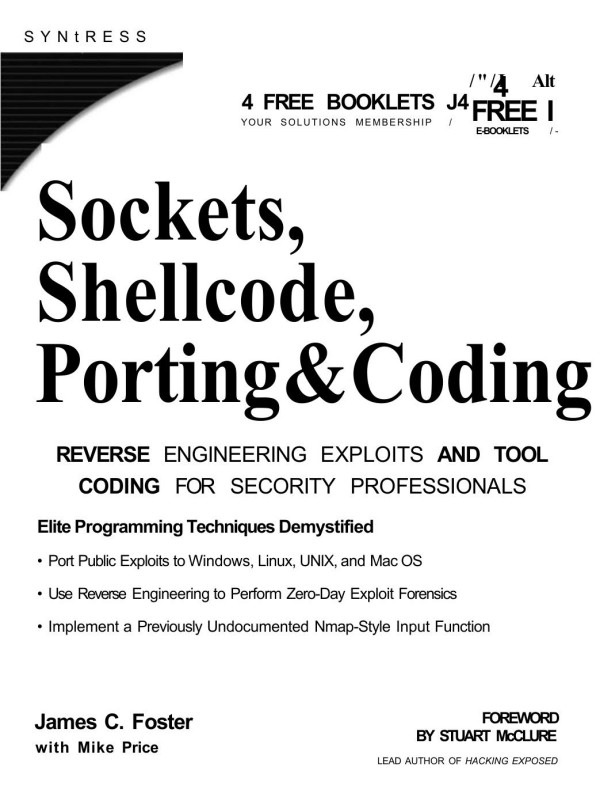Sockets Shellcode Porting and Coding Reverse Engineering Exploits and Tool Coding for Security Professionals 1st Edition by James C Foster ISBN 1597490059 9781597490054
$50.00 Original price was: $50.00.$25.00Current price is: $25.00.
Authors:James C. Foster , Series:Computer Science [103] , Tags:Computer & Internet; Cyber Security , Author sort:Foster, James C. , Ids:1597490059 , Languages:Languages:eng , Published:Published:May 2006 , Publisher:Syngress , Comments:Comments:Syngress would like to acknowledge the following people for their kindness and support in making this book possible. Syngress books are now distributed in the United States and Canada by O’Reilly Media, Inc.The enthusiasm and work ethic at O’Reilly are incredible, and we would like to thank everyone there for their time and efforts to bring Syngress books to market: Tim O’Reilly, Laura Baldwin, Mark Brokering, Mike Leonard, Donna Selenko, Bonnie Sheehan, Cindy Davis, Grant Kikkert, Opol Matsutaro, Steve Hazelwood, Mark Wilson, Rick Brown, Leslie Becker,Jill Lothrop,Tim Hinton, Kyle Hart, Sara Winge, C.J. Rayhill, Peter Pardo, Leslie Crandell, Valerie Dow, Regina Aggio, Pascal Honscher, Preston Paull, Susan Thompson, Bruce Stewart, Laura Schmier, Sue Willing, Mark Jacobsen, Betsy Waliszewski, Dawn Mann, Kathryn Barrett, John Chodacki, Rob Bullington, and Aileen Berg.
Sockets, Shellcode, Porting, and Coding: Reverse Engineering Exploits and Tool Coding for Security Professionals 1st Edition by James C Foster – Ebook PDF Instant Download/Delivery. 1597490059, 9781597490054
Full download Sockets, Shellcode, Porting, and Coding: Reverse Engineering Exploits and Tool Coding for Security Professionals 1st Edition after payment

Product details:
ISBN 10: 1597490059
ISBN 13: 9781597490054
Author: James C Foster
The book is logically divided into 5 main categories with each category representing a major skill set required by most security professionals:
1. Coding – The ability to program and script is quickly becoming a mainstream requirement for just about everyone in the security industry. This section covers the basics in coding complemented with a slue of programming tips and tricks in C/C++, Java, Perl and NASL.
2. Sockets – The technology that allows programs and scripts to communicate over a network is sockets. Even though the theory remains the same – communication over TCP and UDP, sockets are implemented differently in nearly ever language.
3. Shellcode – Shellcode, commonly defined as bytecode converted from Assembly, is utilized to execute commands on remote systems via direct memory access.
4. Porting – Due to the differences between operating platforms and language implementations on those platforms, it is a common practice to modify an original body of code to work on a different platforms. This technique is known as porting and is incredible useful in the real world environments since it allows you to not “recreate the wheel.
5. Coding Tools – The culmination of the previous four sections, coding tools brings all of the techniques that you have learned to the forefront. With the background technologies and techniques you will now be able to code quick utilities that will not only make you more productive, they will arm you with an extremely valuable skill that will remain with you as long as you make the proper time and effort dedications.
*Contains never before seen chapters on writing and automating exploits on windows systems with all-new exploits.
*Perform zero-day exploit forensics by reverse engineering malicious code.
*Provides working code and scripts in all of the most common programming languages for readers to use TODAY to defend their networks.
Sockets, Shellcode, Porting, and Coding: Reverse Engineering Exploits and Tool Coding for Security Professionals 1st Table of contents:
Chapter 1: Introduction to Reverse Engineering and Exploit Development
- What Is Reverse Engineering?
- The Role of Exploit Development in Security
- Legal and Ethical Considerations
- Tools of the Trade
- Disassemblers, Debuggers, and Hex Editors
- Virtual Machines and Sandboxes
Chapter 2: Networking Fundamentals for Exploit Development
- Introduction to Networking Concepts
- Understanding IP, TCP, UDP, and Sockets
- Working with Sockets in Programming
- Networking Tools for Penetration Testing
- Netcat, Nmap, Wireshark
- Crafting Malicious Network Traffic
Chapter 3: The Anatomy of a Buffer Overflow
- What Is a Buffer Overflow?
- Anatomy of a Vulnerability
- Types of Buffer Overflows
- Stack-based and Heap-based
- Exploiting Stack Overflows: Theory and Practice
- EIP Overwriting and Return Address Hijacking
- Exploit Mitigations: ASLR, DEP, and Stack Canaries
Chapter 4: Shellcode Fundamentals
- What Is Shellcode?
- Types of Shellcode: Local vs. Remote
- Writing Simple Shellcode
- Null-free, Executable Code
- Shellcode in Assembly
- Shellcode Injection Techniques
- Using Buffers, NOP Slides, and Stack Manipulation
- Encoding and Polymorphism for Evasion
Chapter 5: Debugging and Reverse Engineering Executables
- Introduction to Debugging
- Static vs. Dynamic Analysis
- Using Debuggers for Reverse Engineering
- OllyDbg, Immunity Debugger, GDB
- Breaking Down Executables: Analyzing Pointers and Addresses
- Identifying Vulnerabilities via Debugging
Chapter 6: Exploit Development: From Discovery to Execution
- Vulnerability Discovery: Tools and Techniques
- Fuzzing, Static Analysis, and Code Auditing
- Writing and Porting Exploits
- Buffer Overflows, Format String Vulnerabilities, and Integer Overflows
- Crafting Reliable Exploits
- Remote Code Execution and Shell Access
- Bypassing Anti-Exploit Mechanisms
Chapter 7: Advanced Shellcode and Techniques
- Shellcode for Various Platforms (Windows, Linux, etc.)
- Advanced Shellcode Techniques
- Reverse Shells, Bind Shells, and Meterpreter Payloads
- Encoding Shellcode to Avoid Detection
- Polymorphic Shellcode and Anti-Debugging Techniques
- Exploit Chain: Combining Multiple Exploits
Chapter 8: Porting Exploits Across Platforms
- Porting Shellcode from Windows to Linux (and vice versa)
- Differences Between 32-bit and 64-bit Architecture
- Dealing with Different Calling Conventions
- Tools for Porting Exploits
- Cross-compilers and Emulators
- Case Study: Porting an Exploit
Chapter 9: Writing Exploit Tools and Scripting
- Introduction to Exploit Frameworks
- Metasploit, Canvas, and Core Impact
- Writing Custom Exploit Scripts in Python
- Integrating with Netcat, Scapy, and other libraries
- Automating Exploit Development
- Using Python for Buffer Overflow Exploits
- Building a Simple Exploit Tool from Scratch
Chapter 10: Web Application Exploits and Reverse Engineering
- Common Web Vulnerabilities
- SQL Injection, Cross-Site Scripting (XSS), Cross-Site Request Forgery (CSRF)
- Reverse Engineering Web Applications
- Analyzing Source Code and Traffic
- Exploiting Web Applications
- Web Shells, Command Injection, and RCE
- Tools for Web Application Penetration Testing
- Burp Suite, OWASP ZAP, SQLMap
Chapter 11: Privilege Escalation and Post-Exploitation
- Privilege Escalation Techniques
- Sudo, SUID, and Capability Manipulation
- Post-Exploitation Strategies
- Maintaining Access: Backdoors and Persistence
- Extracting Information and Dumping Credentials
- Hiding Exploits and Maintaining Stealth
Chapter 12: Anti-Forensics and Evasion Techniques
- Evasion Techniques for Exploit Development
- Obfuscation, Encryption, and Polymorphism
- Bypassing Antivirus and IDS/IPS Systems
- Shellcode Encryption and Code Caves
- Anti-Debugging and Anti-VM Techniques
- Living off the Land (LOTL) Attacks
Chapter 13: Case Studies and Real-World Exploits
- Case Study 1: Exploit Development for Windows Systems
- Case Study 2: Exploiting Web Application Vulnerabilities
- Case Study 3: Writing a Cross-Platform Exploit
- Case Study 4: Exploiting Vulnerabilities in Networking Protocols
Chapter 14: Building Exploit Development Toolkits
- Building Custom Exploit Development Frameworks
- Integrating Debuggers, Fuzzers, and Reverse Engineering Tools
- Automating Shellcode Generation and Exploit Delivery
- Creating a Simple Exploit Development Toolkit
Chapter 15: Mitigation and Defense Against Exploits
- Understanding Exploit Mitigation Techniques
- ASLR, DEP, Stack Canaries
- Defensive Coding Practices
- Static and Dynamic Analysis for Defense
- Building Secure Systems to Prevent Exploits
- Detecting and Mitigating Exploits in Real-Time
People also search for Sockets, Shellcode, Porting, and Coding: Reverse Engineering Exploits and Tool Coding for Security Professionals 1st:
sockets, shellcode, porting, and coding
what is porting a cylinder head
do all spark plugs use the same socket
sockets shellcode porting and coding
c to shellcode












